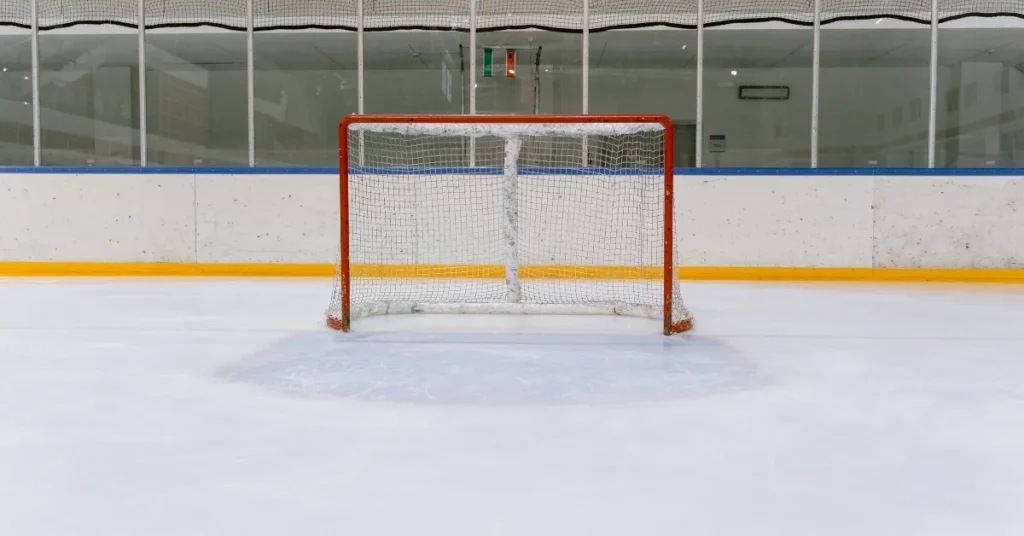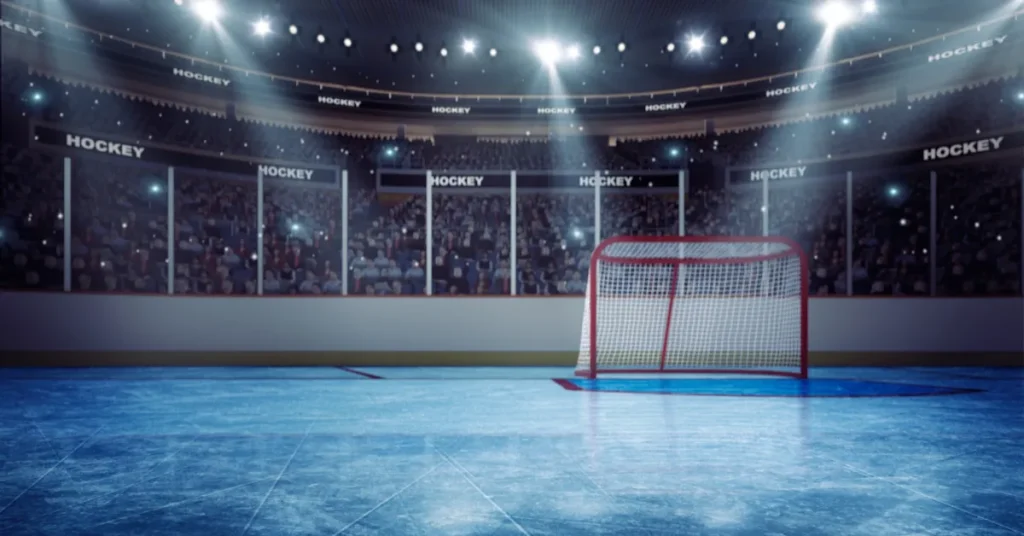A standard hockey rink is 200 feet long and 85 feet wide. These dimensions are official for professional leagues like the NHL.
Exploring the dynamic world of ice hockey, one cannot overlook the significance of the rink’s dimensions.
For players and fans alike, the rink’s size dictates the pace and style of the game. The NHL, known for its fast-paced action, adheres to these measurements, providing a consistent playing field across all teams.
This 17,000-square-foot surface is surrounded by boards and Plexiglass, designed to keep the puck in play and protect spectators.
Recreational and amateur leagues may play on rinks with varying sizes, but they often try to mimic these professional standards to some extent.
This consistent sizing facilitates fair play and ensures that skills developed in one arena are transferable to another, an essential aspect for aspiring players working towards professional leagues.

The Standard Ice Hockey Rink
Imagine the thrill of a fast-paced hockey game, players zooming past in a blur of speed and dexterity.
Central to this exciting spectacle is the ice hockey rink, a stage set for endless athleticism and strategy. A standard rink is more than just a sheet of ice; it’s a well-defined space critically dimensioned for optimum play.
Nhl Regulations
The National Hockey League (NHL) sets strict guidelines for rink sizes. Every NHL game thrives on its fierce competitive spirit, part of which is dictated by rink dimensions, which ensure fairness and uniformity to the game.
- Length: Typically, an NHL rink is 200 feet long.
- Width: The width spans 85 feet.
- Corners: Rounded with a radius of 28 feet.
These dimensions create a space that is very expansive, allowing professional athletes to exhibit their top speeds and skillful moves.
International Rink Sizes
In contrast to NHL standards, international rinks vary slightly. Internationally, the game enjoys a broader stage, which influences the style and tempo of gameplay.
| Dimension | Measurement |
| Length | 197 to 213 feet |
| Width | 98.4 to 100 feet |
| Corners | Radius of approximately 27 feet |
These rinks not only share the allure of larger playing areas but also permit a different strategic approach by the teams. This fact surely adds to the global appeal of ice hockey.
The sizing of the rink is a foundational aspect of the sport, deeply influencing everything from player performance to game strategy.
Both the NHL and international bodies respect these nuances, creating arenas that are not just fields of play, but amphitheaters where the magic of hockey unfolds.
Rink Size Variation
The size of a hockey rink can greatly affect how the game is played. Much like soccer fields, rink dimensions can vary, impacting player strategies and the pace of the game. Understanding the differences in rink sizes across continents is crucial for both players and fans.
North America Vs Europe
Hockey rinks differ significantly between North America and Europe. In North America, the standard rink size is 200 feet in length and 85 feet in width. This is smaller than the European standard.
In Europe, the rink size is larger, measuring 197 to 210 feet in length and 95 to 100 feet in width. This extra space changes how players navigate the game. Below is a comparison table:
| Location | Length (feet) | Width (feet) |
| North America | 200 | 85 |
| Europe | 197 – 210 | 95 – 100 |
Impact On Gameplay And Strategy
Rink size variation has a noticeable impact on gameplay and strategy. Smaller rinks lead to a faster-paced game, encouraging physical play and quick passes. Tighter spaces mean quicker decisions.
Larger rinks provide more room to maneuver, which encourages a strategic, possession-oriented style. Players have more time with the puck, leading to a different style of play.
- Small rink:
- Fast-paced action
- Physical play
- Quick passes
- Large rink:
- Strategic gameplay
- Possession focus
- Space for maneuvers
Components Of A Hockey Rink

Ice hockey thrills fans with its fast-paced action on the rink. Understanding the size and components of a hockey rink helps fans and players alike appreciate the game more deeply. Let’s dive into the details of a rink and explore its layout.
Playing Surface
The playing surface is where the excitement happens. It measures 200 feet in length and 85 feet in width. International rinks are slightly larger, with dimensions of about 197 feet by 98.5 feet. The surface is surrounded by boards made of wood or plastic standing 42 inches tall.
Zones And Markings
Hockey rinks have distinct zones and markings, crucial for game rules:
- The center circle with a 15-foot radius for face-offs.
- Two goal creases, blue semi-circles in front of each net.
- Blue lines, 25 feet from the center line, separate offensive, defensive, and neutral zones.
- Face-off spots and circles, for restarting play after a stoppage.
- Goal lines, where goals are scored, at each end of the rink.
Safety Features
Safety for players and spectators is paramount in hockey rinks.
| Feature | Description |
| Glass Panels | High above the boards to protect spectators and keep the puck in play. |
| Safety netting | Around the rink to catch flying pucks. |
| Padded Posts | Around the goal frame to minimize player injury. |
Together, these features ensure the game runs smoothly and safely for everyone involved.
Comparing Sports Arenas
Ever wonder how big sports arenas are? Let’s dive in and compare. We are looking at hockey rinks versus basketball courts and field hockey versus soccer pitches. Understanding these dimensions helps us appreciate the uniqueness of each sport.
Hockey Vs Basketball
- A standard hockey rink measures 200 feet in length and 85 feet in width. This equates to approximately 61 meters by 26 meters.
- In contrast, a basketball court is significantly smaller. Its dimensions are typically 94 feet by 50 feet. In meters, that’s about 29 by 15.
| Hockey Rink | Basketball Court | |
| Length | 200 feet / 61 meters | 94 feet / 29 meters |
| Width | 85 feet / 26 meters | 50 feet / 15 meters |
Field Hockey And Soccer Pitches
- Field hockey pitches are impressive, stretching 100 yards by 60 yards. That’s 91.4 meters by 55 meters.
- Soccer pitches vary more in size. Yet, they are larger. A common size is 120 yards by 75 yards, or 110 meters by 69 meters.
| Sport | Length Minimum | Width Minimum |
| Field Hockey | 91.4 meters / 100 yards | 55 meters / 60 yards |
| Soccer | 100 meters / 110 yards | 64 meters / 70 yards |
From these comparisons, we can see each sports arena caters to its game. Faster and more fluid games need more space. End-to-end rushes in hockey differ from soccer’s strategic advances. Smaller basketball courts keep the action packed and high scoring.
Evolution Of Rink Sizes

The ‘Evolution of Rink Sizes’ in hockey tells a tale of adapting to the sport’s growing demands. Originally, there were no standard sizes. Today, regulations define dimensions. But this wasn’t always the case. In the past, rink sizes varied widely, often depending on the location and availability of space.
Historical Changes
As hockey’s popularity soared, rink sizes began to standardize. Early ice surfaces were akin to frozen ponds, vastly differing in shape and size. By the late 1800s, specific dimensions were proposed, creating a more uniform playing field.
- First recorded rink dimensions: not standardized.
- 1875: Montreal’s Victoria Skating Rink, 204 by 80 feet.
- Late 1800s to early 1900s: Move towards uniformity.
- 1920s: NHL adopted rink size of 200 by 85 feet.
Teams once used rink size to gain an advantage. Smaller rinks meant more physical play. Larger rinks allowed for faster skating and tactical gameplay.
Future Directions In Arena Design
Emerging technologies shape arena designs. Future rinks may prioritize fan experience and sustainability. Rink sizes could change to optimize players’ performance or to offer more immersive viewing to spectators.
- Adjustable rink sizes with movable boards.
- Green building materials and energy efficiency.
- Technology integration for enhanced spectating.
Designers consider aspects beyond the rink. They include wider concourses, better seating, and advanced lighting systems. Such features make hockey arenas modern entertainment hubs.
FAQs About How Wide Is A Hockey Rink
How Wide Is An Nhl Rink?
An NHL rink is 200 feet long and 85 feet wide.
What Are The Dimensions Of A Hockey Rink In Canada?
A standard hockey rink in Canada measures 61 meters in length and 26 meters in width.
Is Olympic Ice Bigger Than Nhl?
Yes, Olympic ice rinks are larger than NHL rinks. Olympic sheets measure 61 by 30 meters, while NHL rinks are 61 by 26 meters.
Is A Hockey Rink Bigger Than A xFootball Field?
A standard hockey rink is smaller than a football field. While the NHL hockey rink measures 200 by 85 feet, a football field is 360 by 160 feet, including end zones.
Conclusion
Exploring the dimensions of a hockey rink reveals its unique characteristics. With precise measurements, players and fans appreciate the sport’s intricate design. Remember, the standard width is 85 feet in the NHL, setting the stage for thrilling ice action.
Your newfound knowledge enhances viewing and playing experiences, rooting you deeper in the game’s excitement.
Keep this info handy for your next rink visit or hockey trivia challenge!
Resources:
1. https://www.waukeshacounty.gov/landandparks/park-system/ice-arenas/eble-ice-arena/adult-hockey/
